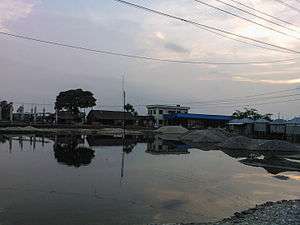Burimari–Lalmonirhat–Parbatipur line
The Burimari–Lalmonirhat–Parbatipur line is a railway line connecting Burimari and Parbatipur Junction in northern Bangladesh. It also connects to Kurigram and Ramna Bazar. This track is under the jurisdiction of Bangladesh Railway.
| Burimari–Lalmonirhat–Parbatipur line | |
|---|---|
 Burimari railway station | |
| Overview | |
| Status | Operational |
| Locale | Bangladesh |
| Termini | Burimari Parbatipur |
| Stations | 23 |
| Operation | |
| Opened | 1878 |
| Owner | Bangladesh Railway |
| Technical | |
| Track gauge | 1,000 mm (3 ft 3 3⁄8 in) metre gauge |
| Operating speed | ? |
Burimari–Lalmonirhat– Parbatipur line | |||||||||||||||||||||||||||||||||||||||||||||||||||||||||||||||||||||||||||||||||||||||||||||||||||||||||||||||||||||||||||||||||||||||||||||||||||||||||||||||||||||||||||||||||||||||||||||||||||||||||||||||||||||||||||||||||||||||||||||||||||||||||||||||||||||||||||||||||||||||||||||||||||||||||||||
|---|---|---|---|---|---|---|---|---|---|---|---|---|---|---|---|---|---|---|---|---|---|---|---|---|---|---|---|---|---|---|---|---|---|---|---|---|---|---|---|---|---|---|---|---|---|---|---|---|---|---|---|---|---|---|---|---|---|---|---|---|---|---|---|---|---|---|---|---|---|---|---|---|---|---|---|---|---|---|---|---|---|---|---|---|---|---|---|---|---|---|---|---|---|---|---|---|---|---|---|---|---|---|---|---|---|---|---|---|---|---|---|---|---|---|---|---|---|---|---|---|---|---|---|---|---|---|---|---|---|---|---|---|---|---|---|---|---|---|---|---|---|---|---|---|---|---|---|---|---|---|---|---|---|---|---|---|---|---|---|---|---|---|---|---|---|---|---|---|---|---|---|---|---|---|---|---|---|---|---|---|---|---|---|---|---|---|---|---|---|---|---|---|---|---|---|---|---|---|---|---|---|---|---|---|---|---|---|---|---|---|---|---|---|---|---|---|---|---|---|---|---|---|---|---|---|---|---|---|---|---|---|---|---|---|---|---|---|---|---|---|---|---|---|---|---|---|---|---|---|---|---|---|---|---|---|---|---|---|---|---|---|---|---|---|---|---|---|---|---|---|---|---|---|---|---|---|---|---|---|---|---|---|---|---|---|---|---|---|---|---|---|---|---|---|---|---|---|---|---|---|---|
| |||||||||||||||||||||||||||||||||||||||||||||||||||||||||||||||||||||||||||||||||||||||||||||||||||||||||||||||||||||||||||||||||||||||||||||||||||||||||||||||||||||||||||||||||||||||||||||||||||||||||||||||||||||||||||||||||||||||||||||||||||||||||||||||||||||||||||||||||||||||||||||||||||||||||||||
| Source: Bangladesh Railway Route Map | |||||||||||||||||||||||||||||||||||||||||||||||||||||||||||||||||||||||||||||||||||||||||||||||||||||||||||||||||||||||||||||||||||||||||||||||||||||||||||||||||||||||||||||||||||||||||||||||||||||||||||||||||||||||||||||||||||||||||||||||||||||||||||||||||||||||||||||||||||||||||||||||||||||||||||||
History
Once Parbatipur came up as a railway station on the Chilahati-Parbatipur-Santahar-Darshana Line in 1876, it became a centre of further railway development. There were two developments, one eastward and the other westward. North Bengal State Railway opened a metre gauge line to Kaunia in 1879. Two narrow gauge lines were laid by Eastern Bengal Railway from Kaunia to Dharla River, thereby creating the Kaunia–Dharlla State Railway. The Kaunia Dharla railway lines were converted to metre gauge in 1901. The Kaunia–Dharla line was extended to Amingaon in 1908. The Assam Behar State Railway started building westward in 1884 and by 1889, Parbatipur was connected with Katihar in Bihar.[1]
By the turn of the century Lalmonirhat Junction had emerged as an important railway centre. Bengal Dooars Railway constructed a line to Malbazar. Cooch Behar State Railway constructed the Geetaldaha-Jayanti narrow gauge line. Links were established with Assam, with the Golokganj–Amingaon line coming up.[1]
Assam links
There were two Assam links through this area, before the Partition of India.
The first and more important one was through Mogalhat–Geetaldaha–Bamanhat–Golokganj. Even when railway links were restored between Pakistan and India in 1955, the line was in order and was one of the agreed transit points.[2] The railway bridge across the Dharla River was subsequently partially washed out and the railway link was snapped.
The second link through Kurigram and Sonahat was snapped earlier with a bridge being washed away within what is now Bangladesh. In 1955, the link was not there.[2][3]
Defunct rail transit point
The Burimari–Changrabandha rail transit point has become defunct. The Indian side of the line is now made BG and is operational between New Mal Junction to Changrabandha. New line has been made to connect New Cooch Behar from Changrabandha.[4]
Bangladeshi side of Burimari-Lalmonirhat track was in bad shape with frequent derailments. There were two local trains in a day running at a limited speed of 8–14 km per hour (as against 45 km per hour in normal sections).[5][6]
But now this side of the Metre gauge line is fully constructed to Lalmonirhat in 2012. Now there running 8 trains daily to different City. The speed limit is 70 kmph. Total nine station of this section are remodeled.[5][6] Bangladesh now making the whole section DG to revive this route. A bridge in River Dharla is being constructed for this.[7]
References
- R.P. Saxena. "Indian Railway History timeline". Archived from the original on 14 July 2012. Retrieved 1 February 2012.
- "Agreement between the Government of Pakistan and Government of India regarding Resumption of Rail Traffic (1955)". Retrieved 1 February 2012.
- "Fencing on Indo-Bangla border in full swing in Assam". The Hindu. Chennai, India. 6 February 2008. Retrieved 1 February 2012.
- Mohan Bhuyan. "International Links from India". IRFCA. Retrieved 10 December 2011.
- "Lalmonirhat-burimari Route −45 trains derail in 5 months – Lack of sleepers, stone makes the run-down track risky". The Daily Star, 7 February 2009. Retrieved 10 December 2011.
- "For better railway between Lalmonirhat and Burimari". The Financial Express, 10 August 2009. Retrieved 10 December 2011.
- "Tk 14,531 crore BR projects to double capacity". Priyo Internet Life. Archived from the original on 6 April 2012. Retrieved 10 December 2011.